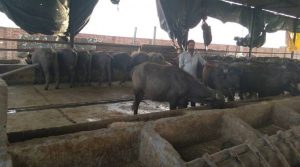What is Animal Husbandry
Animal Husbandry is a branch of agriculture, which comprises of controlled cultivation, management, up keeping and production of domestic animals (like cattles, horses, sheeps etc.) which includes improvement in the qualities considered desirable by humans by means of breeding, genetics, behavior and qualities. Animals are domesticated, bred, maintained and raised for utility (e.g., food, leather, medicines, fur), sport, pleasure, and research.
Importance of Animal Husbandry
It contributes to poverty elevation through increased household income.
It is an integral part of crop farming and contributes significantly to household nutritional. Security.
Better breeding and practices like artificial insemination provide us with better yield with the same input boosting the GDP of a country.
Animal Husbandry also gives way out to researches and development of agriculture sustainable food practices conforming to the environment.
Animal husbandry provides livestock production, which helps as food and various life use products. Examples of these products have been given below:
Dairy Products:
Mammalian livestock can be used as a source of milk and dairy products such as yoghurt, cheese, butter, ice cream, etc.
Meat:
It is the production of a useful form of dietary protein and energy.
Land management:
The grazing of livestock is sometimes used as a way to control weeds and undergrowth. For example, in areas prone to wild fires, goats and sheep are set to graze on dry shrub which reduces the risk of fires.
Fibre:
Livestock produce a range of fibre/textiles. For example, sheep and goats produce wool and deer and sheep can make leather.
Labour:
Animals such as horses, donkey and yaks can be used for mechanical energy. Prior to steam power, livestock were the only available source of non-human labour. They are still used for this purpose in many places of the world, including ploughing fields, transporting goods and military functions.
Fertilizer:
Manure can be spread on fields to increase crop yields. This is an important reason why historically, plant and animal domestication have been intimately linked. Manure is also used to make plaster for walls and floors and can be used as a fuel for fires. The blood and bones of animals are also used as fertilizer.
Main objectives for the the development of Animal Husbandry in Uttar Pradesh are:-
- To provide health coverage to animals, containment of diseases by providing prophylactic vaccination, disease diagnostic and treatment services.
- To provide breeding facilities with advanced technologies and improved genetic stock.
- To evolve an effective and scientific breeding policy to develop animals for specific needs that is high milk yield, meat, egg, wool and draught power etc.
- To improve the feed and fodder resources through extension of area of fodder cultivation with improved fodder varieties , biomass production, silvipasture development and enrichment of cellulosic waste.
- In order to maintain the genetic diversity, conservation of indigenous breeds of cows and buffaloes.
- To develop all livestock species and poultry with marketing back up and support services.
- Increase production of milk, meat, egg, wool and other livestock products through qualitative and quantitative improvement in production potential of livestock and through disease control activities.
- To provide self employment opportunity subsidiary occupation and income to larger section of population in the rural areas as well as to ensure proper availability of quality animal protein and nutritious diet.
- To encourage occupational diversification of people.
- To reduce the number of non-descript livestock population so as to reduce pressure on land and fodder resources.
Various Plans and Programs for the Development of Animal Husbandry are:-
- Scheme for improvement and expansion of animal breeding facilities by artificial insemination and natural conception in cow / buffalo (District Planning)
- Prevention of infertility in animals / buffaloes (state planning)
- Hydro-emission Semen Production Center (State Planning)
- Foot, mouth disease control program-100 percent funded Center
- Rinderpest Eradication Program- 100% Centered Conservancy
- 75% Centrally Sponsored Scheme (ASPAD) for the control of animal diseases.
- Establishment of UP Veterinary Council is centrally sponsored by 50%
- Livestock Production and Management statistical studies and research
- 10000 poultry farming I plan
- 30000 layers of poultry scheme
- Backyard poultry scheme
- Broiler poultry scheme under National Agriculture Development Scheme

- Rural Backward Poultry Program
- Schemes operated under Veterinary Services and Animal Health
- Establishment, development, reinforcement and breeding facilities of sugar fields (Dist.)
- Sucre Training Center and Diagnostic Laboratory Aligarh reinforcement
- UPPCS Mains Tests and Notes Program 2025
- UPPCS Prelims Exam 2025- Test Series and Notes Program
- UPPCS Prelims and Mains Tests Series and Notes Program 2025
- UPPCS Detailed Complete Prelims Notes 2025